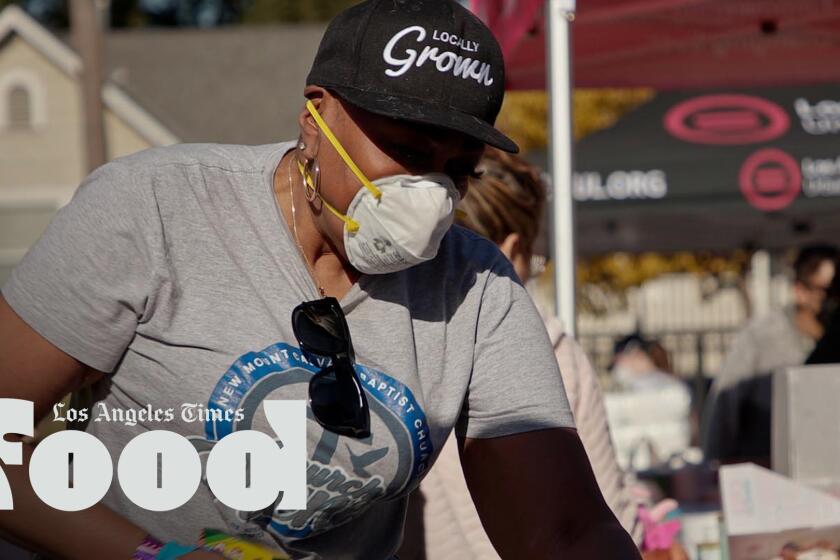Find L.A.’s revolutionary next-wave pizza at these new restaurants
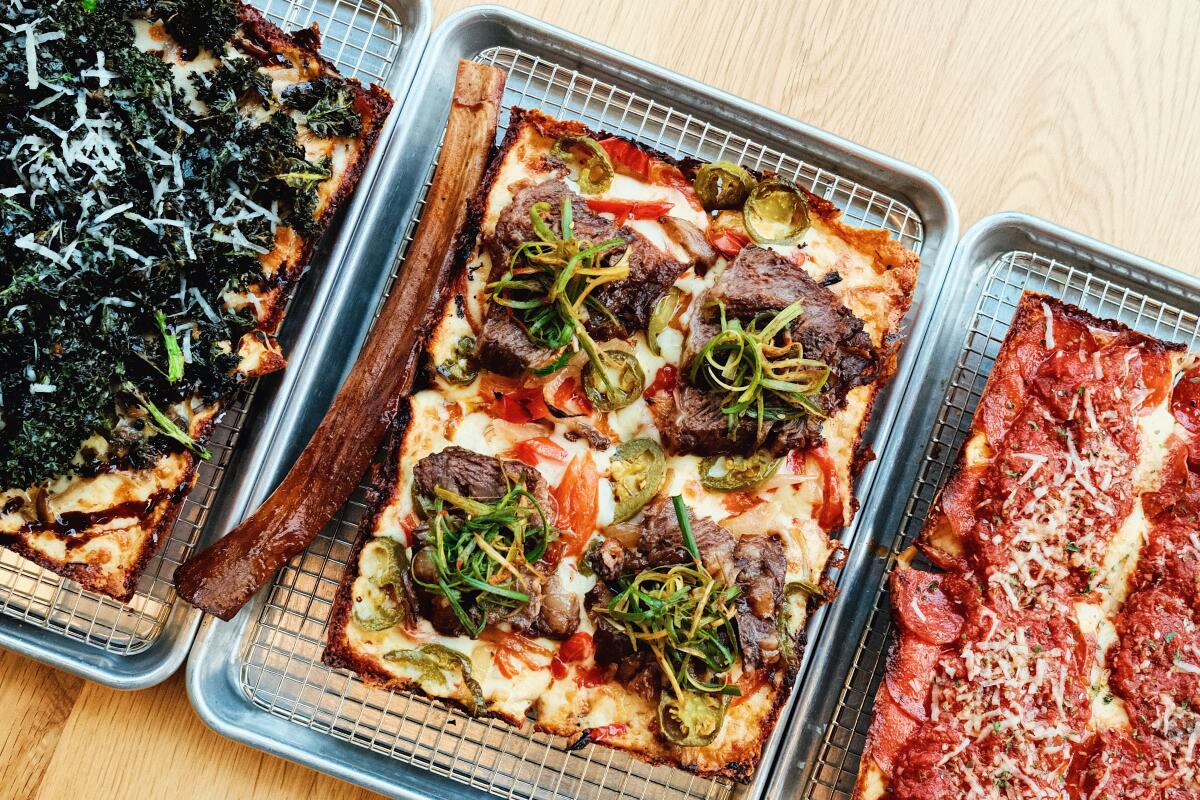
- Share via
Los Angeles is a pizza town. While chefs and diners grapple with the question of what defines an L.A.-style pie, the fact remains that there’s a bevy of nearly every variety to be found: Neapolitan, Detroit-style, the New York slice, Chicago-inspired deep dish, and the fluffy Sicilian.
Here are three new restaurants adding some unique pizzas to the scene — whether it’s served in a garden that also provides the toppings or piled with Korean barbecue, featuring a galbi bone as garnish — plus, a pizza omakase launched by one of L.A.’s 101 Best Restaurants.
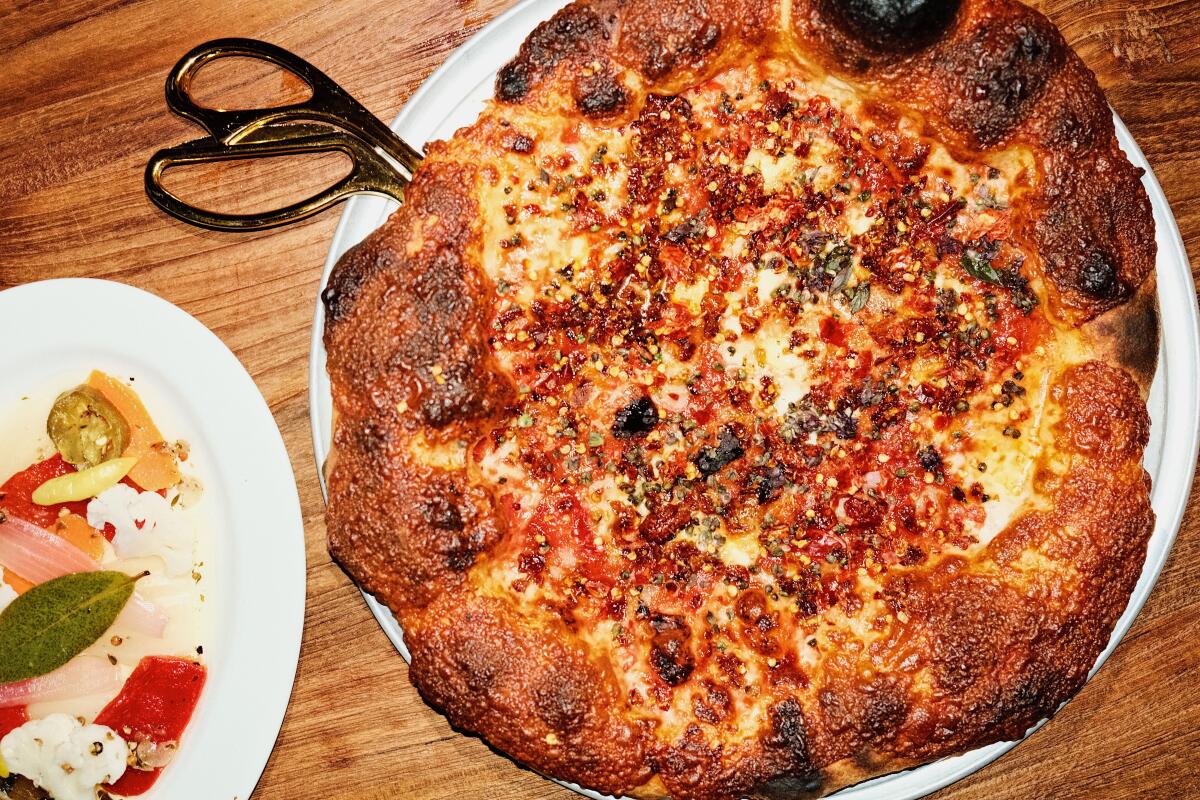
Leopardo
The first thing you see is the pizza oven, an immediate signal to your brain that — while you might find oysters with pickled-seaweed granita, polenta waffles with corncob butter and caviar, and grilled squid filled with its roe at Leopardo — you must order the pizza.
Celebrated chef Joshua Skenes’ latest restaurant could be making L.A.’s most enthralling pizza, served alongside a raw bar, wood-grilled meats and seafood, as well as a wildly inventive cocktail menu. The mozzarella cheese is house-made. The sauce is handmade and canned by the team. The ingredients are meticulously sourced.
“The original impetus for this thing was to get crazy with the pizza, and to do it in kind of my way,” said Skenes, the former Saison and Angler chef-founder. “We had some pretty wild pizzas lined up, because the idea was to think of this dough as a vehicle for so many different shapes and ways to stretch the dough and roll it out.”
That dough took a lot of work.
Skenes wanted to build a pizzeria specializing in his wild-yeasted dough made with roughly a dozen stone-ground flours sourced from up and down the West Coast. He and his team tested around 100 varieties of flours to determine their favorites, then tested through hundreds of recipe variations. The final dough in the pizzas is cooked at 600 degrees for a crisped bottom that’s sliced at the table with scissors. It’s also used for the razor-thin, house-made herbed crackers that accompany uni with California bluefin tuna as well as the pillowy, fluffy grilled flatbread served with elk tartare and bone marrow.
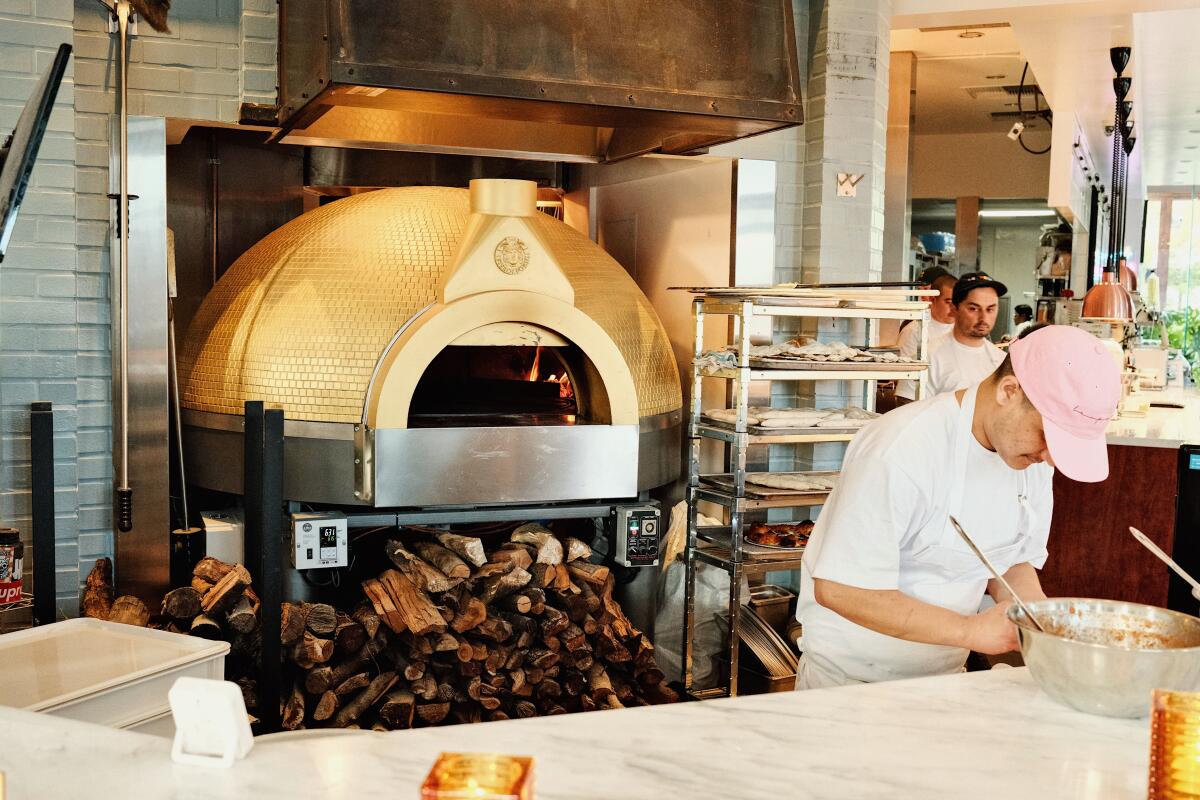
When it comes to the pizza at the new restaurant bordering Mid-Wilshire and Hancock Park, the cheese and sauce extend to the crust, which both keeps the edges of the pie juicer and develops a thin sheer of just-charred cheese that looks as dark and hard as charcoal but buckles under even the softest touch. It’s a pizza of contrasts.
“It has elements from a bunch of different things, but I’m approaching it from purely a textural and flavor standpoint rather than any one label,” Skenes said. “Labels don’t mean anything to me. To me, it’s the net reality of what’s on the plate.”
The topping preparation began roughly a year before opening, with Skenes and his team building their Leopardo larder, fermenting ingredients and canning what the chef estimates was 12 tons of Early Girl tomatoes.
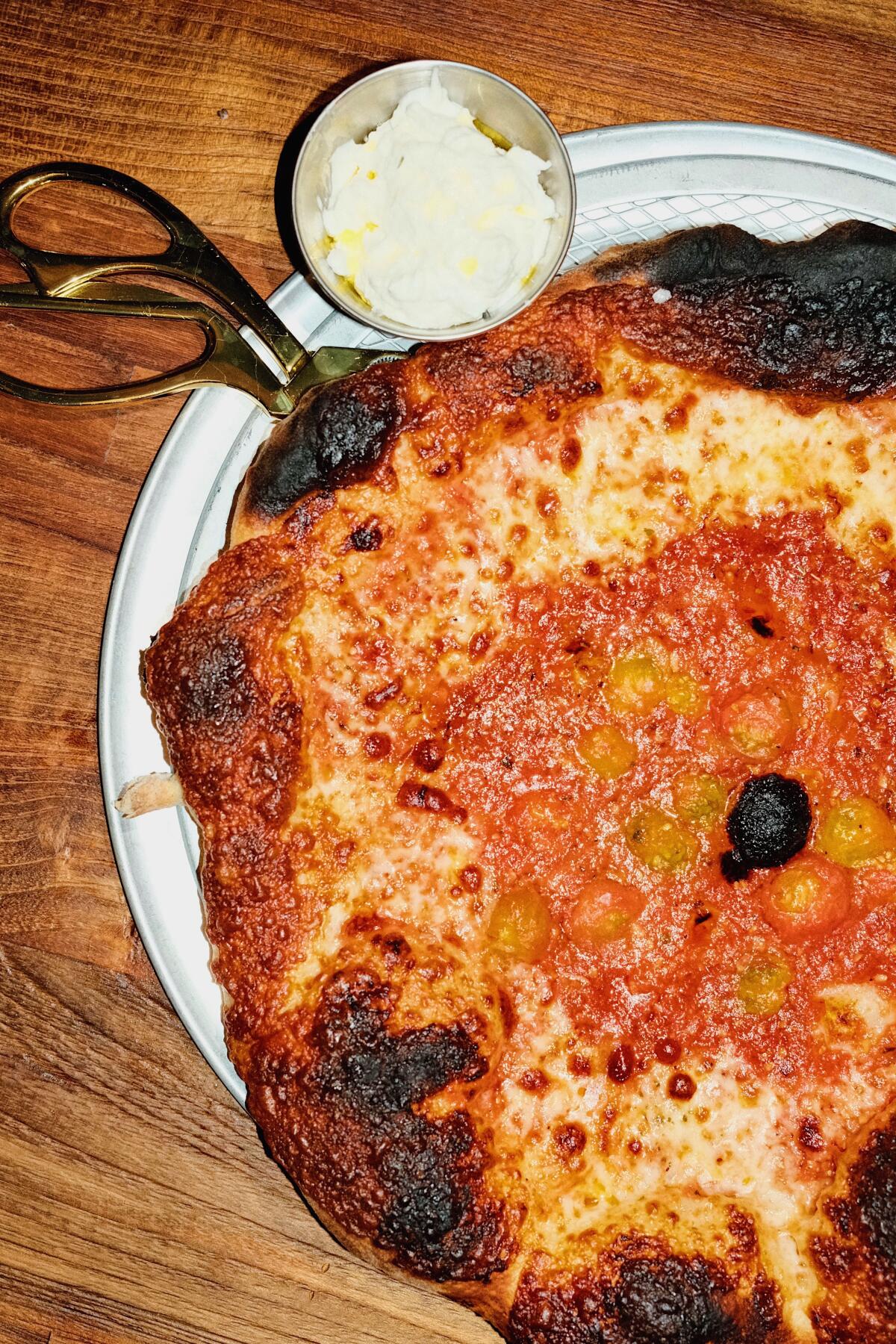
The stracciatella begins with a purchased mozzarella that the kitchen transforms into the wetter, creamier cheese using cream from California’s Straus Family Creamery. There are amazing products from Italy, the chef said, but by the time they arrive, they’re no longer the same.
Perfecting the house-made mozzarella for the pizzas was a science. “The moisture content has to be perfect, the thickness of the slice has to be perfect, the flavor has to be perfect to be able to still retain that sweet mozzarella flavor at the end when it’s caramelized, the structure of the cheese has to be perfect so it doesn’t break,” he said. “There’s a lot of things involved there.”
For his Re-Marinara pizza, Skenes and his team thinly slice a whole smoked ham leg and grill it over a mix of woods, then infuse it into their Early Girl tomato sauce. The Hello Satan — salumi and chile with wildflower honey — gets a side of house-made giardiniera for a hit of acid. For now, the list of pizzas, which also includes a Margherita, is small. But Skenes plans to expand it, as well as adding a patio surrounded by greenery. In the coming months he hopes to launch lunch service, weekday breakfast and a brunch service that might see wild boar roasting on a spit.
Leopardo is open from 5:30 to 10:30 p.m. Tuesday to Saturday.
460 S. La Brea Ave., Los Angeles, leopardola.com

Seven Tigers Pie Club
When Alex Sohn debuted Calic Bagel last fall, he knew that the now-viral bagel shop he founded with his wife, Sun, was only the beginning for the lively green-and-white restaurant bordering Westlake and Koreatown. Someday, he hoped, it also would be home to Seven Tigers Pie Club. Earlier this month it became reality, and now the Korean-inspired bagels in the daytime fade into an evening menu of cheese-crusted, deep-dish pizzas that load Detroit-style square pies with L.A.-inspired toppings like al pastor and sauces such as gochujang marinara.
Sohn, who is also behind quick-and-casual restaurants Egg Tuck and Yup Dduk, wants to explore what L.A. pizza is and can be.
“L.A. people want everything: They want thin crust, they want heavy, they want crispy, they want a lot of toppings, so we’re going to try a lot of things,” he said. “There will be a lot of people who will be kind of questioning our long journey, but I mean, that’s the point.”
He tapped Noel Brohner of consulting group Slow Rise Pizza Co. to help develop the recipes over the course of the last year, and in the process they created a 48-hour fermented hybrid dough that would lend itself well to square deep-dish pan pizza with crispy, cheesy crust as well as more ubiquitous, thinner round styles. The same dough serves as the bread for a small menu of foldover sandwiches. The focus at Seven Tigers Pie Club, though, is on the L.A.-inspired square pies.
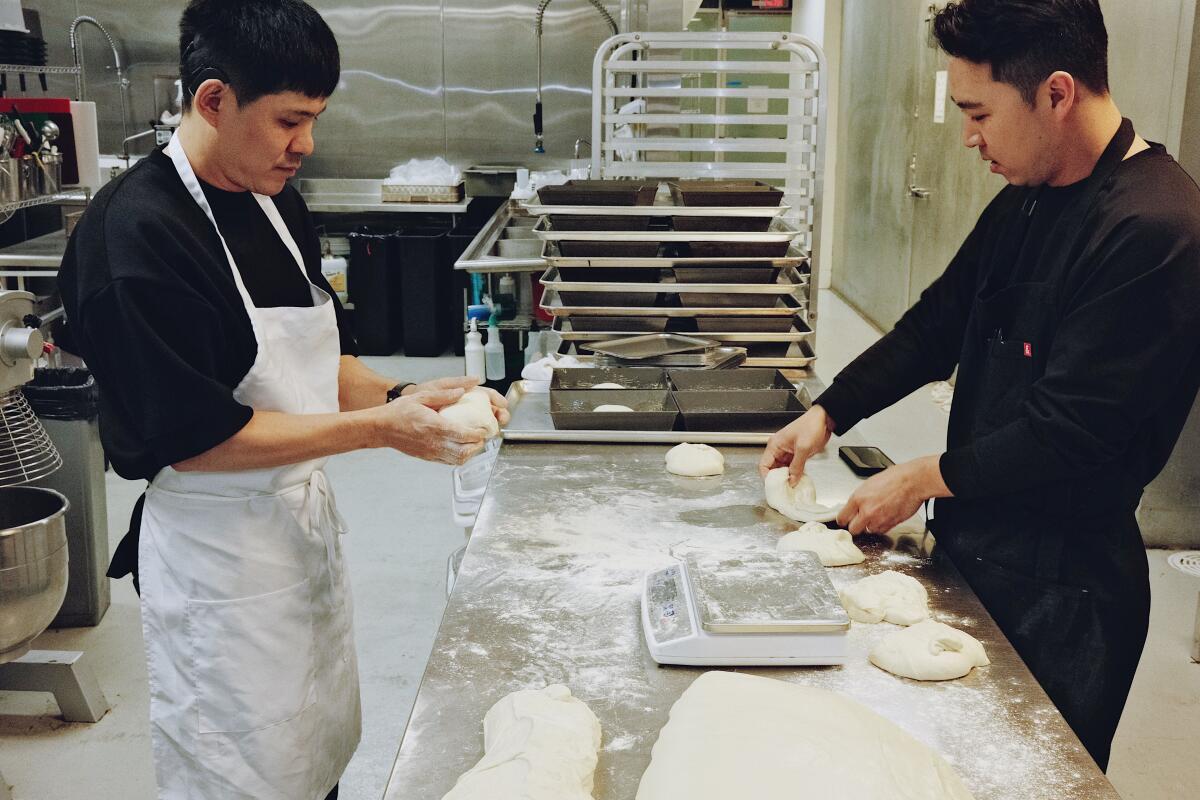
Its signature pizza, the Grand Short Rib, is an ode to Koreatown’s vast KBBQ scene. It involves a galbi-sauce base, tender peppers and onions, pickled jalapeños and a blend of cheddar and mozzarella before topping each slice with fatty, fall-apart morsels of 24-hour-slow-cooked Angus beef short rib. It’s all garnished with a tangle of pa muchim, or scallion salad, and the short rib bone comes resting alongside the pie for a flourish.
The pepperoni pizza weaves gochujang into its marinara, while Seven Tigers’ homage to L.A.’s taco stands stacks al pastor onto a square pie with pickled onions and pineapple. Sohn is experimenting with Thai flavors and exploring what American flavor is — a cheeseburger-inspired pie and collaborative options could find their way to the menu soon.
The “hate comments,” Sohn said, have already started rolling in, declaring that this isn’t L.A.-style pizza, but Detroit-style. “But as our dough consultant [Brohner] says: Nobody calls it Detroit-style pizza inside Detroit — it’s just regular pizza,” Sohn said. “It’s just the outsider [who’s] calling it Detroit-style pizza.”
Seven Tigers Pie Club is open from 5 to 9:30 p.m. Wednesday to Sunday.
2748 W. 8th St., Los Angeles, (213) 868-3330, almghospitality.com/seventpc
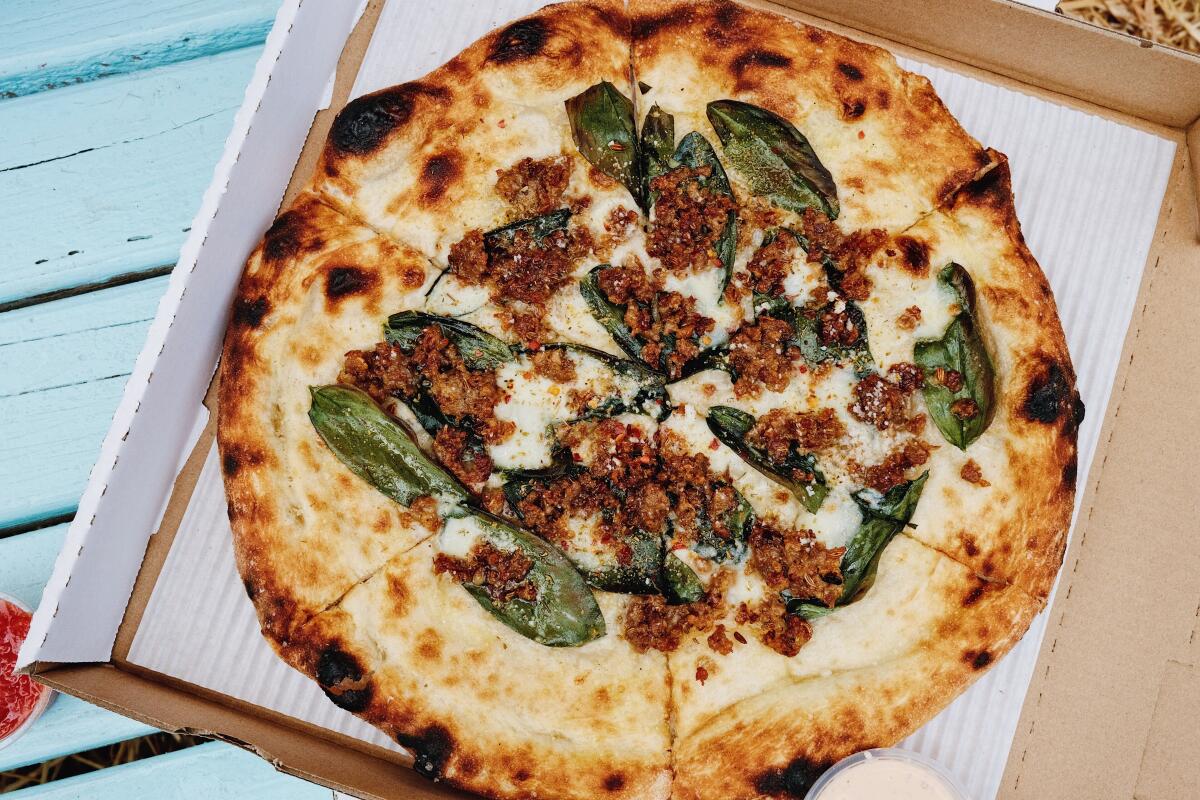
Fiorelli Pizza
It’s fairly easy to spot the aquamarine pizza oven stationed amid the vines and flowers in the Cook’s Garden Venice, and if you see patrons enjoying slices straight from the box at scattered blue picnic tables, there’s no doubt about it: You’ve found Fiorelli Pizza.
The new mobile operation from chef Michael Fiorelli and his business partner, Elizabeth Gutierrez, is serving bright, chewy-dough pizzas that fall somewhere between Neapolitan and New York style and come topped with simple, seasonal ingredients — including some grown right there in the urban garden.
“I think that it’s unique,” said Fiorelli, former Olivetta and Love & Salt chef and an Italian American from Long Island who grew up working in pizzerias. “I think between the flavor and the fermentation and the hydration and the temperature of the cooking, we have a very unique pizza.”
Fiorelli craves more structure than the wetter center of a Neapolitan pie and opted for a sturdier bottom à la New York’s variety. But he loves the cook style, freeform toppings and crust of the Neapolitan. So he borrows from both, splitting the difference on the hydration of his dough and the temperature and time in the oven. By cooking his pizzas at 700 degrees — lower than a classic Neapolitan and roughly a minute longer — the center holds, which has been the No. 1 compliment that Fiorelli and Gutierrez have received thus far.
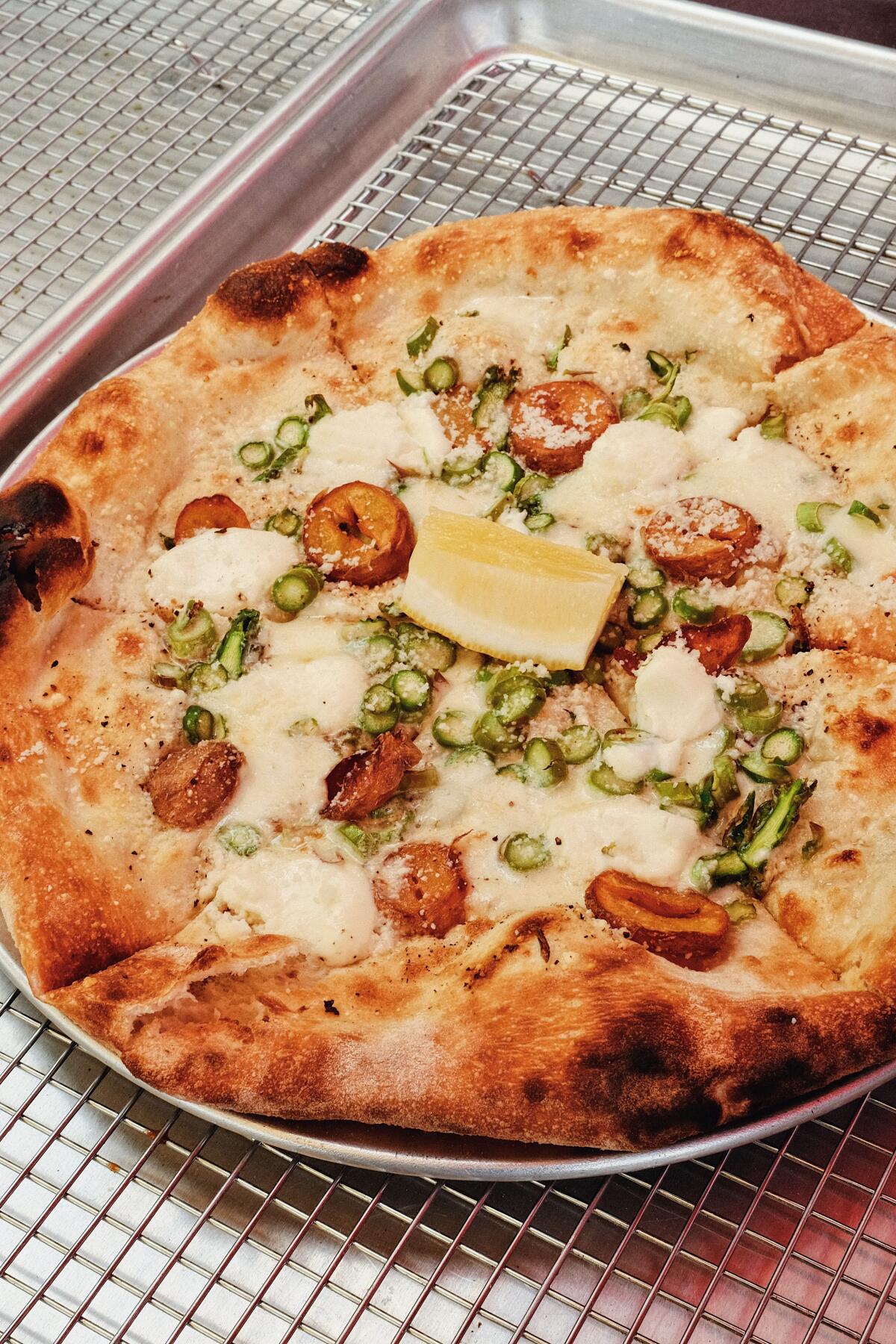
The dough prep is done “around the clock,” and mostly in a West Hollywood prep kitchen. Incorporating a fermented dough starter, it’s not quite a sourdough but carries hints of that tang. Once formed and rested, the dough gets batched and brought to Venice, where it’s topped with a simple base of Bianco canned tomatoes blended with sea salt and aged Parmesan; dry mozzarella cheese, New York-style; garden-grown ingredients such as freshly picked fava leaves; house-made pork sausage; or shaved asparagus with a wedge of fresh lemon.
The crust gets brushed with olive oil and flecked with sea salt before it’s all fired in an oven fueled by almond wood. The dough also serves as a fluffy flatbread for dishes such as Spanish sardines with pickled peppers and house-made black olive butter.
Fiorelli and Gutierrez said they aren’t planning a permanent location of Fiorelli Pizza. Given the difficulties in operating a restaurant right now, they’d be surprised if more restaurateurs don’t shift to mobile, stripped-down formats.
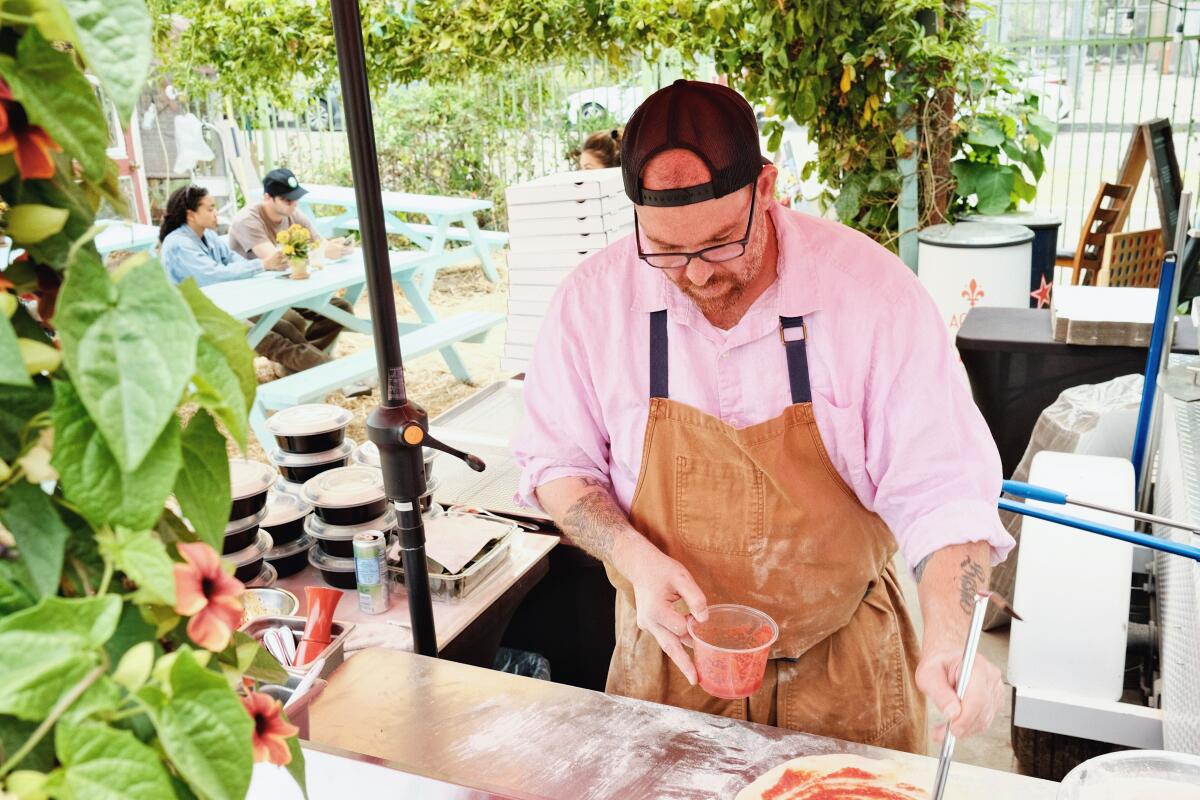
“We didn’t want to take those big loans,” Fiorelli said. “It’s so hard for mom-and-pop restaurants, all restaurants, right now. ... We wanted something that we can control 100% and to reconnect with what we do — and that’s hospitality. That’s food and people, and now we get to meet and greet everybody that comes in here.” Find Fiorelli Pizza operating inside the Cook’s Garden Venice at least through the summer from 1:30 to 7 p.m. Thursday to Sunday.
1033 Abbot Kinney Blvd., Venice, instagram.com/fiorellipizza
Pizzeria Sei’s pizza omakase
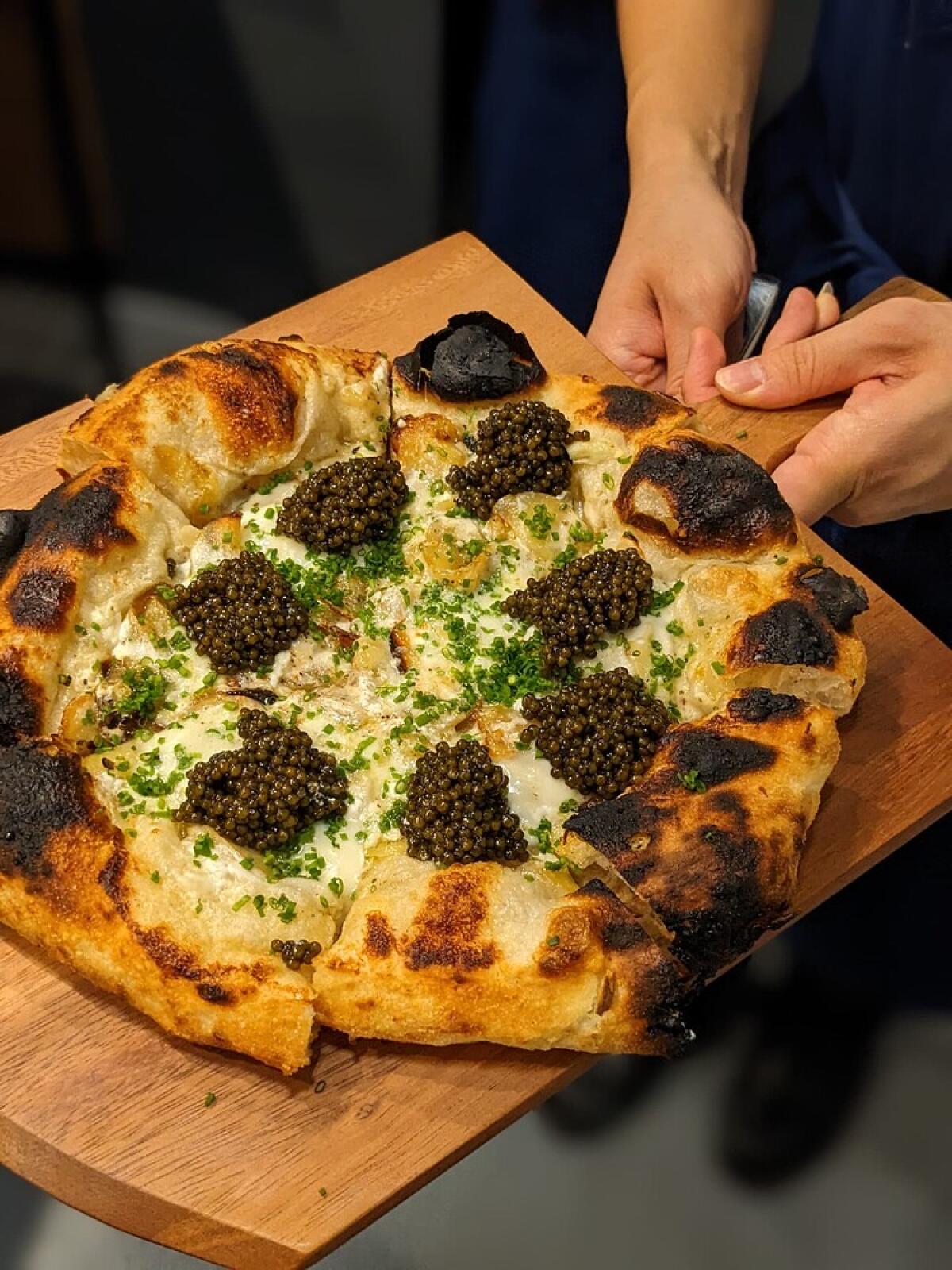
This L.A. Times 101 Best Restaurant is already a hard table to land, but Pizzeria Sei’s new pizza omakase is selling out almost as soon as its ticket sales are announced via social media. William Joo, chef-owner of the Pico-Robertson restaurant, is using the new series to experiment with doughs, toppings and styles that build on his already popular neo-Neapolitan, Tokyo-style pies with just-firm centers and puffy, chewy, crimped crusts.
Described by Joo as a passion project, the pizza omakase is hosted on select Tuesday nights when Pizzeria Sei is normally closed. The rotating menu might highlight inspiration from one of the most famous pizzas in Tokyo, or nod to L.A. in the form of Thai or Korean pies.
“The first year [at Pizzeria Sei] I was very afraid to put the different toppings on the pizza,” said Joo, “but now after seeing how guests receive it, it changed my way of thinking a lot. Now I feel like pizza should be fun.”
The omakase includes roughly eight slices, plus dessert and an amuse bouche, and possibly a calzone.
The series debuted in mid-May, and Joo hopes to host two omakase nights per month. The special menu is inspired by Tokyo’s the Pizza Bar On 38th, which has offered a pizza omakase for years, as well as Arts District kaiseki experience and fellow L.A. Times 101 Best Restaurants pick Hayato. While Hayato’s Japanese fine dining does not include pizza of any form, Joo said that chef-owner Brandon Go’s dedication and course-by-course explanation of food and philosophy informed his decision to attempt his own version at Pizzeria Sei.
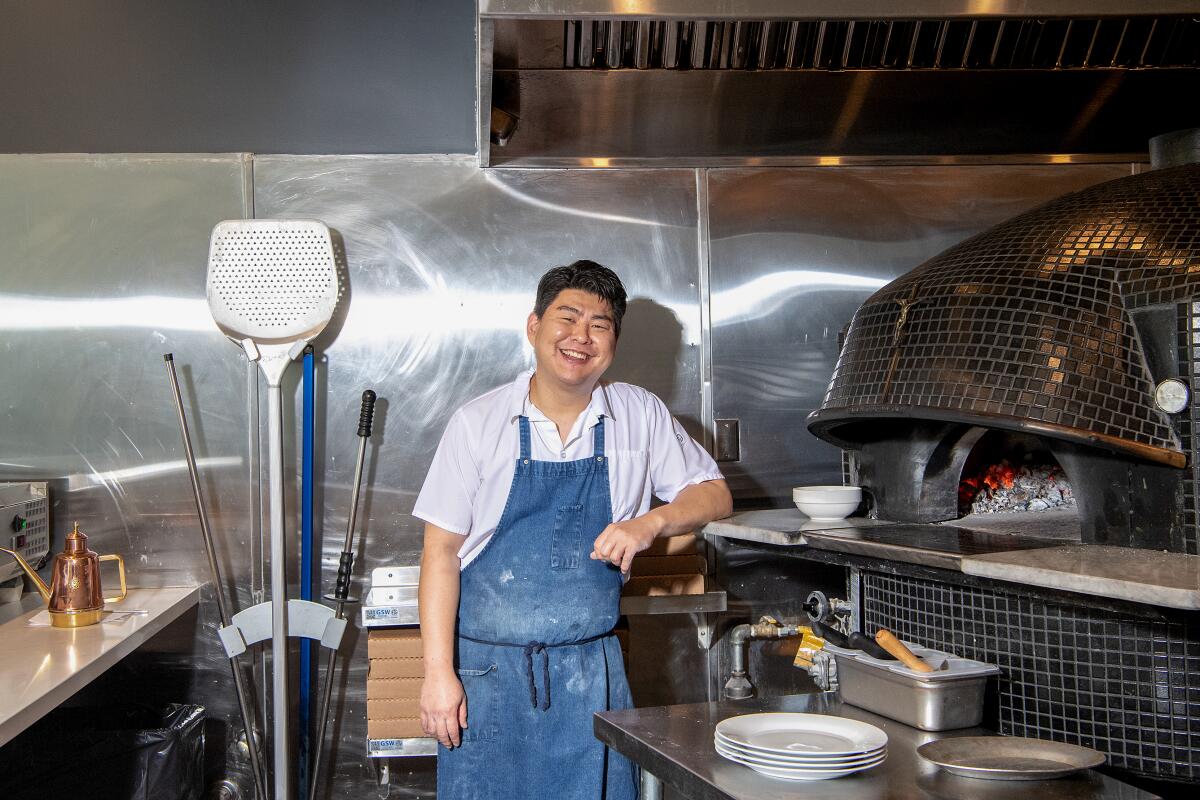
An eye-catching bigeye tuna pizza is served as an ode to Tokyo’s famed version at Savoy, which is topped with Yamayuki bluefin; in Joo’s Pico-Robertson shop he took a page from a mentor, Providence chef and sustainability champion Michael Cimarusti, and instead sourced line-caught tuna from Hawaii. Another pizza — topped with mala spice, lamb sausage, smoked provola cheese, crème fraîche and cilantro flowers — is a nod to Koreatown restaurant Feng Mao, famed for its grilled lamb skewers. Another local favorite, Thai seafood restaurant Holy Basil, inspired a pizza topped with Panang curry, tom yum spice, shellfish oil, whole prawns and Thai basil. The most luxe on the menu piles caviar onto a potato-and-cheese pie.
The doughs, too, receive their own treatment. Some feature Pizzeria Sei’s standard dough, puffy and mochi-like chewy around the crust. Joo also is employing a “double-baked” dough, which is fried, baked and dried for a crispier, sturdier consistency; a higher-moisture dough, which is softer and airier; and a chocolate dessert dough. Joo is also experimenting with nori dough for a kimbap-leaning pizza reminiscent of his childhood; the experimentation, he said, is neverending.
“It’s continuous improvement,” Joo said. “It’s like a journey for me.”
8781 W. Pico Blvd., Los Angeles, (424) 279-9800, pizzeriasei.com
More to Read
Eat your way across L.A.
Get our weekly Tasting Notes newsletter for reviews, news and more.
You may occasionally receive promotional content from the Los Angeles Times.









